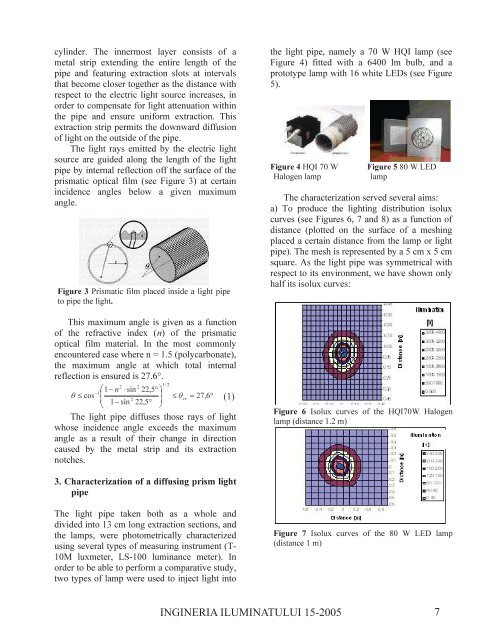Ingineria Iluminatului - Journal of Lighting Engineering - Prof. Florin ...
Ingineria Iluminatului - Journal of Lighting Engineering - Prof. Florin ...
Ingineria Iluminatului - Journal of Lighting Engineering - Prof. Florin ...
Create successful ePaper yourself
Turn your PDF publications into a flip-book with our unique Google optimized e-Paper software.
cylinder. The innermost layer consists <strong>of</strong> a<br />
metal strip extending the entire length <strong>of</strong> the<br />
pipe and featuring extraction slots at intervals<br />
that become closer together as the distance with<br />
respect to the electric light source increases, in<br />
order to compensate for light attenuation within<br />
the pipe and ensure uniform extraction. This<br />
extraction strip permits the downward diffusion<br />
<strong>of</strong> light on the outside <strong>of</strong> the pipe.<br />
The light rays emitted by the electric light<br />
source are guided along the length <strong>of</strong> the light<br />
pipe by internal reflection <strong>of</strong>f the surface <strong>of</strong> the<br />
prismatic optical film (see Figure 3) at certain<br />
incidence angles below a given maximum<br />
angle.<br />
Figure 3 Prismatic film placed inside a light pipe<br />
to pipe the light.<br />
This maximum angle is given as a function<br />
<strong>of</strong> the refractive index (n) <strong>of</strong> the prismatic<br />
optical film material. In the most commonly<br />
encountered case where n = 1.5 (polycarbonate),<br />
the maximum angle at which total internal<br />
reflection is ensured is 27.6°.<br />
2 2<br />
1/<br />
2<br />
⎛1<br />
− n ⋅sin<br />
22,<br />
5°<br />
⎞<br />
−1<br />
θ ≤ cos ⎜<br />
⎟ ≤ θ = 27,<br />
6°<br />
⎜<br />
2<br />
cr ⎟<br />
(1)<br />
⎝ 1−<br />
sin 22,<br />
5°<br />
⎠<br />
The light pipe diffuses those rays <strong>of</strong> light<br />
whose incidence angle exceeds the maximum<br />
angle as a result <strong>of</strong> their change in direction<br />
caused by the metal strip and its extraction<br />
notches.<br />
3. Characterization <strong>of</strong> a diffusing prism light<br />
pipe<br />
The light pipe taken both as a whole and<br />
divided into 13 cm long extraction sections, and<br />
the lamps, were photometrically characterized<br />
using several types <strong>of</strong> measuring instrument (T-<br />
10M luxmeter, LS-100 luminance meter). In<br />
order to be able to perform a comparative study,<br />
two types <strong>of</strong> lamp were used to inject light into<br />
the light pipe, namely a 70 W HQI lamp (see<br />
Figure 4) fitted with a 6400 lm bulb, and a<br />
prototype lamp with 16 white LEDs (see Figure<br />
5).<br />
Figure 4 HQI 70 W<br />
Halogen lamp<br />
Figure 5 80 W LED<br />
lamp<br />
The characterization served several aims:<br />
a) To produce the lighting distribution isolux<br />
curves (see Figures 6, 7 and 8) as a function <strong>of</strong><br />
distance (plotted on the surface <strong>of</strong> a meshing<br />
placed a certain distance from the lamp or light<br />
pipe). The mesh is represented by a 5 cm x 5 cm<br />
square. As the light pipe was symmetrical with<br />
respect to its environment, we have shown only<br />
half its isolux curves:<br />
Figure 6 Isolux curves <strong>of</strong> the HQI70W Halogen<br />
lamp (distance 1.2 m)<br />
Figure 7 Isolux curves <strong>of</strong> the 80 W LED lamp<br />
(distance 1 m)<br />
INGINERIA ILUMINATULUI 15-2005 7
















